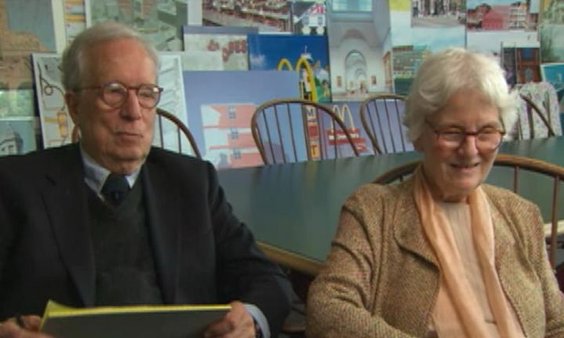[RV] As you mentioned earlier this morning Denise, probably one interesting irrelevant subject would be our attitude towards… the… of architecture as loft, as flexibility, and when we talk about that we are reacting against a… an approach that’s popular today and fashionable among architects, is to design buildings which are highly dramatic in terms of their form, that are kind of almost sculptural, abstract sculptural form, and that derived possibly in a perverse way, out of the idea, the early modern idea, which was good then, of form follows function. And… but usually, it isn’t really form following function, in this case it is again the desire for dramatic architectural expression, a kind of abstract expressionism. We like to say that it is appropriate now that you say form accommodates functions, plural, rather that form follows function.
Now, it’s interesting that we pointed out that two of the, you know, famous and maybe best architects of the 20th century who were kind of enemies, both said form follows function. It’s down in writing. Le Corbusier and Frank Lloyd Wright. We like to say that that approach kind of parallels the idea of the building as a glove that follows the function in a very precise way. There’s a finger that’s longer here than there is one that’s longer here. We like to say that for now, the tradition of the architecture as a mitten, form accommodates functions, and then there can be change, wiggle room, as it were, inside; and there’s a long tradition of that, which perhaps Modernism was reacting against. You find it in… all of the Modernists liked American… American industrial factories, but the American, the loft building was that, where a lot of things can happen flexibility inside, the industrial loft. The academic loft building, Nassau Hall, Princeton or William and Mary Hall, in that college where many things could happen within that building, and it could accommodate time and… change in time. Or the Italian Palazzo, which started out as a noble residence, but could then easily become a library, a museum, and other kinds of… accommodate other kinds of uses over time. Where you had a series of rooms en suite, they weren’t exactly physically flexible inside, but because of the general approach, they were right. So that’s the opposite of form follows function.
The trouble with form follows function, also, is that it does kind of forget the important quality of architecture as shelter, and that… that is very important in another context, where the idea of the element of space has been not so important in the 20th century – architecture as space. Well, architecture is space, but it is also shelter.
And then, not to go on too long about this, but we are now saying, among other things, that architecture very much connects with the function, the element let’s say, not the function, the element of iconography of architecture as sign. Our latest book is called Architecture as Signs and Systems, and again, we refer to a long history of that, of architecture where there are hieroglyphics all over the… all kinds of buildings, columns, walls. In Egyptian architecture, there are pediments in classical architecture where yes, there is art in the pediment via the sculpture, but that sculpture was instructing you concerning the religion of the era. Or you go to the Christian, early Christian basilica, where you look down, and along the walls are… are mosaics and, that… that instruct in form as well as ornament. And it is interesting that maybe we should look at such element and art, not so much as art, such an element in architecture is not so much art but as signage, that is done in such an effective way that it incidentally becomes art.
And then we, of course, go to the idea of the significance today, of learning from the American commercial vernacular, where… which depends enormously on signs, signage, billboards and things like that, and that… could parallel the significance of the American, mostly American, industrial vernacular that was so important as a basis for modern architecture. At the beginning of the century all the buildings were made to look like elegant factories, now, should it not be that perhaps buildings should look like the commercial, or learn from, at least connect with, the commercial, industrial, pop, ordinary kind of architecture that exists today, should that be a basis for the architecture now?
So, the importance of the flexible loft, and the importance of the building at the same time as iconographic, as an element of signage, we like to think of as important. We’ve written a lot about… no one is connecting with it much. They’re beginning to a little, and of course, we are at the same time saying that by forgetting the industrial factory, we are also going from the last part of this century which, where we are no longer in the industrial age, we are in the electronic age – we call it also the iconographic age – and that our technology is no longer industrial, although, no, it’s no longer essentially industrial in its architectural expression, it is iconographic dash electronic. And there’s lots of opportunity there for that kind of glitter, that would parallel the glitter, let’s say… from the inside of Gothic churches, where you have the glitter, the art of the stained glass windows, but they also, of course, have content, and if you were a person in the Middle Ages, you are admiring them, and looking at them to learn from and read from.





